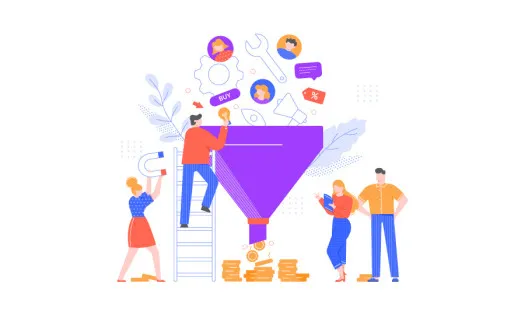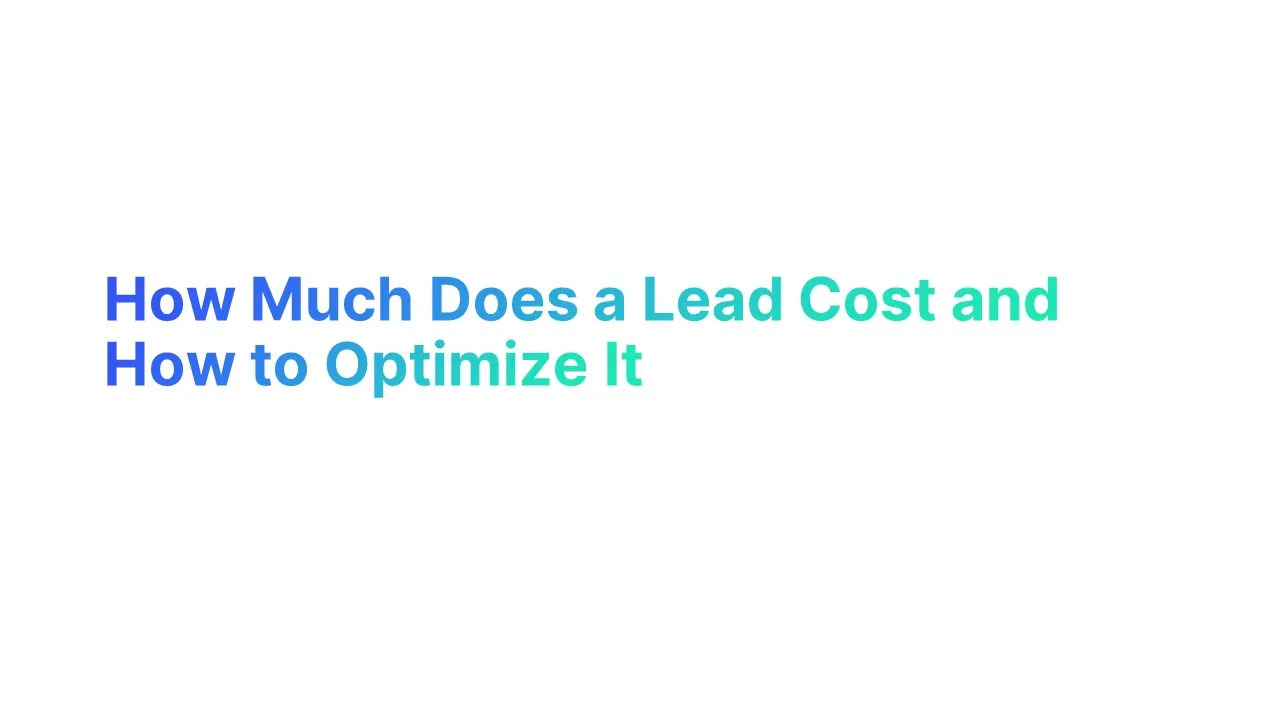What are Lead Costs?

Lead costs refer to the amount of money a business spends to generate leads, which is a potential customers who has shown interest in your product or service. The leads cost of acquiring leads can vary widely depending on the industry, target market, and effectiveness of lead generation strategies.
These costs are influenced by several factors including the marketing channels used to generate leads, the complexity of the sales process, and the quality of leads generated. Understanding lead costs is crucial for management and finance teams to ensure the profitability and sustainability of lead generation efforts.
How Many Leads Do You Need?
Determining the number of qualified leads you need involves understanding your company's sales team goals, conversion rates, and the average sales price of your products or services. Here's a step-by-step approach to calculate this:
Sales Goals: Start with your company's revenue targets for a specific period.
Conversion Rates: Analyze how many leads typically convert into paying customers.
Average Sales Price: Consider how much an average customer spends.
Calculate Leads Required: Divide your revenue target by the product of the conversion rate and average sales price.
This calculation will give you an estimate of the generation cost and how many leads are needed to meet your financial goals.
How to Calculate Cost Per Lead (CPL)?

Cost per Lead (CPL) the average cost per lead is a key metric in evaluating the efficiency of your lead generation cost strategies. It is calculated as follows:
Total Spend on Lead Generation: This includes all expenses related to generating leads such as advertising, marketing campaigns, and payments to lead generation agencies.
Total Number of Leads Generated: The total leads acquired through these efforts.
Formula:
CPL = Total Spend on Lead Generation / Total Number of Leads Generated
This metric helps businesses track their investment in lead generation cost and adjust one lead to strategies to improve return on investment (ROI).
What is a Good Cost Per Lead?
A "good" cost per lead varies significantly by industry, market, and the client pays specific business model. However, a good CPL should align with the company's overall profitability goals and the lifetime value of a customer. Factors to consider include:
Industry Average Cost: Comparing your CPL to the industry average can provide insight into your marketing efficiency.
Profit Margins: Ensure the cost of acquiring a lead is significantly lower than the revenue generated from that lead.
Customer Lifetime Value: A higher lifetime value might justify a higher CPL.
Businesses should aim for a CPL that allows them to maximize their profit while sustaining growth.
How Much Should a Lead Cost Your Business?
Determining how much a lead generation agency should cost your business requires a detailed understanding of your financials and marketing strategy:
Budget and Financial Goals: Your lead cost should fit within your overall marketing budget while helping achieve financial targets.
Target Market and Sales Process: Costs can be higher for markets with complex sales processes or high-value products.
Evaluate Lead Quality: Higher quality leads that are more likely to convert can justifiably cost more.
Benchmarking: Compare your lead costs with competitors and industry standards to ensure you are not overpaying.
An effective pricing model for leads involves balancing cost with lead quality and potential revenue from ongoing lead generation work, ensuring every dollar spent contributes to the company's growth and profitability.
Average Cost per Lead

Understanding the average cost per lead is critical for businesses to gauge the efficiency of their lead generation efforts and to adjust their strategies accordingly.
This metric varies widely based on industry, the channels used, company size, and revenue, reflecting the diversity of markets and tactics employed.
Average Cost per Lead by Industry
The cost of acquiring a lead can differ significantly across industries due to varying customer behaviors, product types, and competition levels. For example:
B2B Industries: Generally have higher costs per lead due to longer sales cycles and more complex decision-making processes. Industries like IT and telecommunications might see average costs per lead ranging from $100 to $350.
B2C Industries: Tend to have lower cost per lead, especially in more direct consumer markets like retail or consumer goods, where leads might range from $10 to $50.
Highly Competitive Industries: Such as legal services or insurance, can experience even higher costs per lead, sometimes exceeding $400, due to the high value of converted leads.
Average Cost per Lead by Lead Generation Channel

Different marketing channels offer varying effectiveness and cost-efficiency, influenced by how target customers use these platforms:
Search Engine Optimization (SEO): Often provides one of the most cost-effective channels, with leads generated through organic search typically costing less due to the 'free' nature of organic traffic.
Paid Search Advertising: Costs can vary widely, with highly competitive keywords increasing costs significantly. Average costs per lead can range from $50 in less competitive sectors to $200 or more in industries like legal or insurance.
Social Media Marketing: Platforms like LinkedIn for B2B and Facebook for B2C also vary, with LinkedIn leads generally costing more due to its professional network context, averaging around $75, while Facebook might range around $30.
Average Cost per Lead by Company Size
Company size impacts lead generation costs through differences in resources, brand recognition, and customer reach:
Small Businesses: May have higher costs per lead, often due to lower efficiencies and smaller scale of operations, which can limit their negotiating power and access to bulk rates in advertising or data purchasing.
Large Enterprises: Often benefit from lower costs per lead as they can leverage economies of scale, more substantial brand presence, and more significant data insights to optimize campaigns effectively.
Average Cost per Lead by Company Revenue
Revenue levels can also play a role in determining the average cost per lead, largely due to the different investment capabilities and the strategic focus of the companies:
High-Revenue Companies: Typically have more funds to invest in comprehensive lead generation strategies which can initially drive up costs. However, their ability to engage in more extensive testing and optimization can lead to lower costs over time.
Lower-Revenue Companies: Might need to be more conservative in their spending, focusing on lower-cost channels like SEO or minor PPC campaigns. This can limit their reach but also control costs more tightly.
The average cost per lead varies by industry, channel, company size, and revenue. Companies must analyze these factors in their specific contexts to determine where efficiencies can be gained.
Continuously pushing existing lead generation companies based on these insights is crucial for maintaining a competitive edge and achieving better ROI.
4 Factors Affecting Lead Cost

Understanding the cost of acquiring leads is crucial for optimizing lead-gen business and marketing efforts and ensuring profitability in lead-generation strategies. Here are four key factors that significantly influence your lead generation business' costs:
1. Industry
The industry in which a business operates significantly impacts the cost of generating leads. Different industries have varying average costs per lead due to factors like company size, product complexity, average sales price, and customer lifecycle. For example:
B2B Lead Generation: Typically involves higher lead costs than B2C due to the complex nature of transactions, longer sales cycles, and higher stakes involved.
Highly Regulated Industries: Such as finance or healthcare, often face higher costs due to additional compliance and trust barriers that require more sophisticated and thus costly marketing efforts.
Moreover, the profit margin expectations within an industry also dictate how much can be reasonably spent on acquiring each lead, influencing the overall lead pricing strategy of lead generation campaigns.
2. Competition
The level of competition in the market plays a critical role in determining lead costs. In highly competitive markets, the demand for attention from potential customers increases, which can drive up the cost of lead generation. Key lead generation pricing considerations include:
Ad Spending: Competitive markets often see higher costs in channels like social media advertising and search engine marketing as businesses bid for prominent placement.
Innovation in Lead Gen Tactics: To stand out, companies might need to invest in more innovative and engaging lead generation tactics, which can increase costs.
Effective strategies to make sales funnel manage costs in competitive environments include focusing on niche segments of the market or employing less saturated marketing channels to reach potential customers.
3. Size & Quality of Target Audience

The characteristics of your target audience, including their size and quality, significantly affect lead costs:
Audience Size: Larger target audiences generally allow for economies of scale in lead generation, potentially lowering the cost per lead as marketing efforts can be spread across a broader base.
Quality and Precision: More precisely defined target audiences tend to have higher lead costs due to the need for targeted marketing efforts, such as advanced segmentation and personalized marketing tactics. However, this can also lead to higher quality leads, which might be more cost-effective in the long term if they convert at higher rates.
Utilizing customer relationship management (CRM) systems and data analytics can help fine-tune pricing strategies and the understanding of your audience, allowing for more cost-effective targeting.
4. Accessibility to Target Audience
How easily a business can reach its potential customers also influences lead costs. Factors affecting lead price and accessibility include:
Marketing Channels: Some channels, such as digital marketing through social media platforms, provide direct and cost-effective access to large audiences. In contrast, more traditional channels like direct mail or television may incur higher costs.
Geographic Factors: If the target audience is concentrated in a particular area, localized marketing strategies can be more budget-friendly. Conversely, dispersed audiences might require broader, more expensive outreach efforts.
Moreover, the use of lead generation channels that align with the preferences and behaviors of the company revenue target audience can improve lead quality and reduce waste in marketing spend.
By considering these factors—industry, competition, audience size and amount bulk data quality, and accessibility—businesses can develop more informed strategies that balance lead cost with lead quality, ultimately enhancing the effectiveness of their lead generation efforts and improving overall ROI.
5 Lead Generation Strategies

Effective lead generation is vital for businesses to grow their customer base and increase revenue. Here are five robust lead generation strategies that can help businesses optimize their efforts and reduce overall lead generation costs:
1. Using Lead Generation Tools
Leveraging the latest lead generation tools can streamline the process and improve efficiency. These tools can help in various aspects:
Automation Software: Tools like HubSpot or Marketo automate tasks such as email marketing and social media posts, saving time and ensuring consistent lead engagement.
CRM Systems: Customer Relationship Management systems help track interactions with potential and current customers, optimizing the nurturing process and improving conversion rates.
SEO Tools: Platforms like SEMrush or Ahrefs aid in optimizing content and keywords to boost search engine rankings, driving organic traffic to your site.
By using these tools, businesses can enhance their lead generation efforts, ensuring they attract more qualified leads at a potentially lower cost.
2. Buying Lead Lists
Purchasing lead lists is a common strategy for quickly accessing a pool of potential customers. Key considerations include:
Vendor Reputation: Choose reputable vendors to ensure the data is accurate and up-to-date.
Data Relevance: Ensure the lead lists are relevant to your business needs and target market, which increases the likelihood of conversion.
Compliance: Be aware of privacy laws and regulations such as GDPR when buying and using lead lists.
While buying lead lists can provide immediate access to potential leads, the quality and conversion rates may vary, affecting the overall effectiveness of this strategy.
3. Lead Generation Agencies
Lead generation agencies to specialized agencies can be advantageous, particularly for businesses without in-house expertise or resources:
Expert Handling: Agencies bring experience and tools that may be too expensive or complex to develop internally.
Scalability: Agencies can adjust the volume of lead generation efforts according to your business needs.
Cost-Effectiveness: Paying lead generation agencies might be more cost-effective than building and maintaining an in-house team, especially when considering the broad range of tactics they can implement, from SEO to social media marketing.
Selecting the right lead generation agencies is crucial, as it should align with your business values and understand your target market.
4. Paid Ads and Promotion Costs
Paid advertising is a direct method to generate leads. This includes:
Search Engine Marketing (SEM): Paid search ads can drive targeted traffic to your landing pages. The cost can vary widely based on the competition for keywords and the average sales price of your product.
Social Media Advertising: Platforms like Facebook, Instagram, and LinkedIn offer advanced targeting options to reach specific demographics, interests, and behaviors.
Content Promotion: Promoting valuable content through these paid channels can attract potential leads by offering them useful information.
Monitoring ROI on these platforms is essential to ensure that the cost per lead is justified by the lead quality and conversion rate.
5. Hiring and Training Marketing Specialists
Investing in a skilled marketing team is critical for developing and executing effective lead generation strategies:
Hiring Specialists: Recruit individuals with expertise in areas critical to lead generation, such as digital marketing, content creation, and data analysis.
Continuous Training: The digital marketing landscape is continually evolving; regular training can help your team stay updated on the latest trends and tools.
Team Structure: Design a team that can handle various aspects of lead generation, from creating content and running ads to analyzing data and nurturing leads.
Building a capable marketing team can lead to more innovative and effective lead generation strategies, potentially lowering costs and increasing the generation of high-quality leads.
Implementing these strategies requires careful planning and evaluation to ensure they align with your business objectives and lead generation goals. By effectively utilizing tools, resources, and external expertise, companies can optimize their lead-generation efforts and improve their return on investment.
How to optimize lead generation Costs?

Optimizing lead generation costs is crucial for maximizing the efficiency of your marketing budget and improving your return on investment.
Here are strategic ways to reduce costs while maintaining or even improving the quality of leads generated:
1. Use a high-quality lead data provider
Choosing a reliable and high-quality lead data provider ensures you are not wasting resources on outdated or irrelevant data. Key considerations include:
Accuracy and Relevance: Ensure the provider updates their databases frequently to provide the most current information.
Segmentation Capabilities: Good providers offer detailed segmentation options that allow you to target leads more precisely, which can improve conversion rates and reduce costs.
Compliance: Ensure the data provided complies with relevant regulations such as GDPR to avoid legal issues that could result in fines.
3. Target leads when they are ready to buy
Timing your outreach can significantly impact the effectiveness of your lead generation efforts:
- Buying Signals: Use tools and CRM systems to monitor potential leads' behavior and engagement levels. For instance, reaching out to a lead who has just downloaded a high-intent content piece like a pricing guide may yield better results.
- Lead Scoring: Implement a lead scoring system that helps prioritize leads based on their actions and engagement level, indicating readiness to purchase.
4. Narrow down your target audience
Refining your target audience to focus on those most likely to convert can dramatically decrease your lead costs:
- Detailed Buyer Personas: Develop detailed personas based on real data and insights from your existing customers.
- Market Segmentation: Use market segmentation to categorize your audience by demographics, psychographics, and behaviors to tailor your marketing strategies effectively.
5. Adjust ad frequency and messaging on different channels
Customizing how often and what you communicate through your ads can enhance lead quality and decrease waste:
- Ad Frequency Optimization: Adjust the frequency of ads based on user interaction and engagement to avoid ad fatigue.
- Channel-Specific Messaging: Tailor your messages according to the platform to resonate better with the audience specific to each channel (e.g., professional tone on LinkedIn, more casual on Instagram).
6. Use inbound marketing methods
Inbound marketing is a cost-effective strategy that attracts customers by creating valuable content and experiences tailored to them:
- Content Marketing: Develop and distribute relevant and valuable content to attract and engage a clearly defined audience.
- SEO: Optimize your website and content for search engines to increase organic traffic and lead capture.
- Social Media Marketing: Engage with potential leads through regular updates, informative posts, and community management.
7. Improve your landing page design
The design and usability of your landing pages can have a significant impact on conversion rates:
- User Experience (UX) Design: Ensure your landing pages are easy to navigate, visually appealing, and mobile-friendly.
- A/B Testing: Regularly test different elements of your landing pages (such as CTAs, images, and layout) to see which versions perform best and optimize accordingly.
- Clear Call-to-Action: Your landing page should have a clear, compelling call-to-action that directs visitors to take the next step in the sales funnel.
By implementing these strategies, businesses can significantly reduce the cost per lead while enhancing the effectiveness of their lead generation campaigns. This results in a more streamlined, cost-efficient process that drives better results and higher returns on investment.
Concluding Thoughts
In conclusion, understanding and optimizing lead costs are paramount for any business aiming to enhance profitability and sustain growth. The cost of a lead can significantly impact a company's bottom line, and varies widely based on industry, target market, and the effectiveness of lead generation strategies. By analyzing key metrics like Cost Per Lead (CPL) and comparing them against industry standards, businesses can identify areas for improvement. Strategies such as refining target audiences, optimizing ad spending, and employing cost-effective lead generation tools are vital. Ultimately, a well-balanced approach that considers both the cost and quality of leads will ensure that investments in lead generation deliver the best possible return on investment, driving both growth and profitability.









